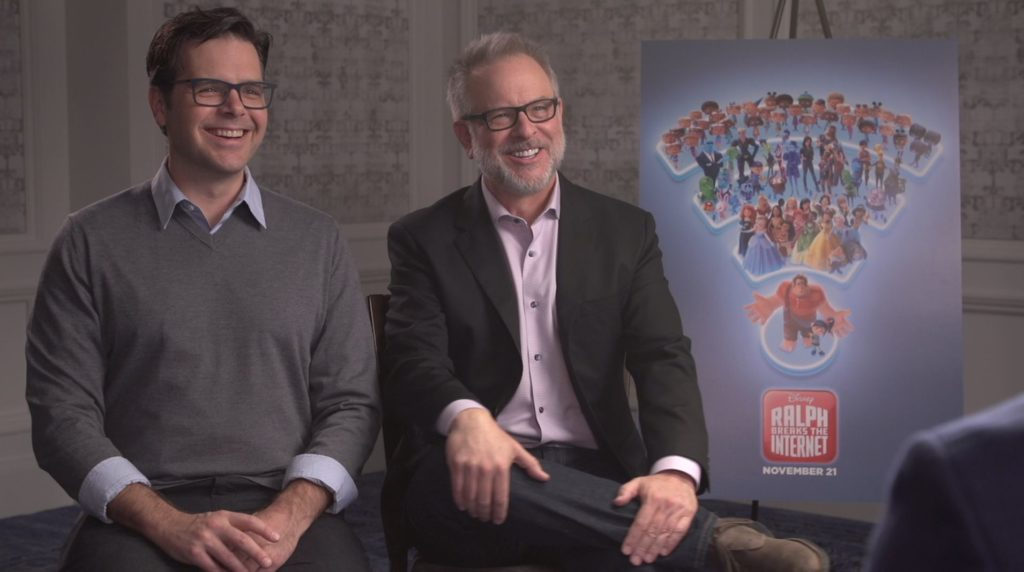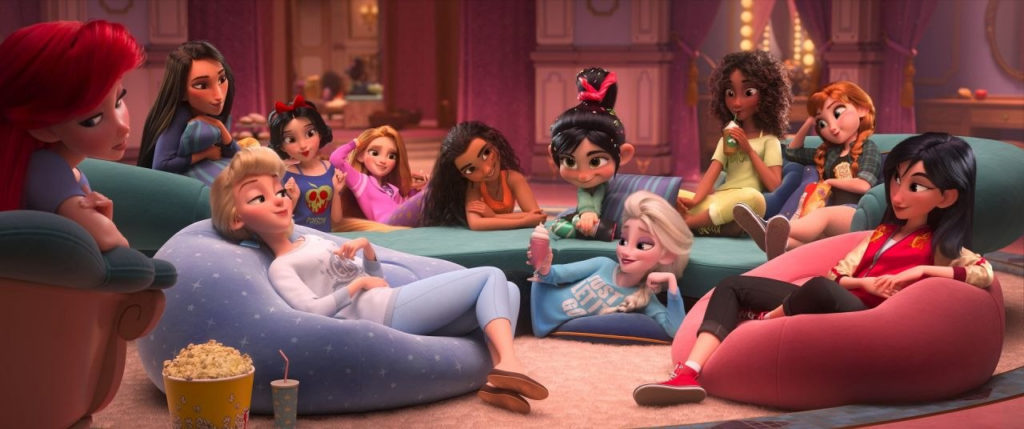“These stories are meant to live for a very, very long time and the way that you get to that kinda story is you work it.”
-Rich Moore, co-director of Ralph Breaks The Internet
Perhaps Rich Moore, co-director of Walt Disney Animation Studios’ Ralph Breaks The Internet may have just revealed the secret to what sets Disney animation aside from the other movie studios competing in the animation genre. “You kick it around and you look at it from all angles and you try to hone it and make it the best it can possibly be,” Moore reveals. “It takes time,” the co-creator says, adding that you can’t just snap your fingers or wave a magic wand and your movie is complete. That investment in time, money, blood, sweat and tears pays off ultimately. “It’s like ordering an acorn to grow into an oak overnight. It’s not gonna happen.”
The Academy Award-winning director and his colleague Phil Johnston stopped by Philadelphia to talk up Ralph, Vanellope, the Disney Princesses and a whole host of new animated characters in their new movie. The follow-up to 2012’s Wreck-it Ralph marks the first feature-length theatrical sequel from Walt Disney Animation Studios since 2011’s Winnie the Pooh.
Moore explains that there is a process to making Disney animated films “that requires that you really work them out.” He notes that “this one we made in three-and-a-half years, maybe four, that’s about average for an animated film at Disney or Pixar.”
Moore and Johnston, who both worked on 2016’s Oscar-winning Zootopia admit that the technology used in that flick gave them the ability to build a world as big as a city where distinct districts were fully realized and uniquely populated. They said they wanted to benefit from the lessons learned from Zootopia in creating the world of the Internet. The result is a universe big and dense with characters and places to go. Moore observes that Ralph Breaks The Internet is “the most complex animated film we’ve ever made in terms of locations, characters and heavy design and assets.”
Where Wreck-It Ralph dealt in the nostalgic world of video games, Johnston notes “not everyone had that experience growing up. In a lot of places in the world, that wasn’t really a thing. So this one is the Internet.” He adds that even his 83-year-old father has had experience with the worldwide web, noting that “there are very few people on the planet who don’t have a relationship to the Internet.”
And so how were they able to incorporate many of those day-to-day Internet sites like eBay, Google and Twitter into their movie without having to worry about copyright infringement? As Johnston explained it “it is copyright law and fair use, so we actually don’t have to get permission just to use the signs.”
Equally important and Disney geeks want to know is how did they manage to incorporate Disney royalty into their gem of a movie without ruffling a few princess gowns? “We ask ourselves the same question everyday and have for the last three years,” admits Johnston. “When the idea emerged a couple of years ago, we very quickly story-boarded the scene similar to as it is written now with some exceptions and we took it to the heads of Disney just to say ‘look we’re rolling the dice on this, can we keep going and they said yes keep going and actually push it farther’” Both men joke that the “rest of the world gets to poke fun at Disney, why can’t we make fun at ourselves.”
Johnston likens it to needling family and friends. “You tease each other but it is done with love and I think the satire of these characters is done with an abiding love and respect for the legacy of all of them, so I think that is why Disney was like go with God have fun.”
Eleven of the 14 original voice actresses returned for the project with Moore noting that “everyone was very game to come back and play those parts again and we wondered are any of the actresses going to balk about this and think that this is not in good taste. But everyone loved it. Everyone got it and several of them actually when we recorded it, several of them would read it as written and then say, ‘you know she would actually say it a little bit more like this.’ It really gave that authenticity to those characters. Everyone had such a good sense of humor with the scene.”
Speaking of a sense of humor, it was a joke about Star Wars’ Kylo Ren that stirred up fans of that galaxy far, far, away. Moore confesses “well it wasn’t a very good joke. It was more us kinda self-editing ourselves. We tried lots of things in that Oh My Disney section and there’s a pile somewhere of jokes, darlings that just kinda died by the wayside. We wanted the movie to be as perfectly possible as it can and that involves pitching lots of different things.”
Achieving that perfection is a hallmark for Disney whether in television, animation or live action films. That is why when a flap erupted over Princess Tiana’s skin tone the issue was addressed straight on. Johnston says the challenge with Tiana was “she was originally a 2-D hand-drawn character and in us transferring her into CG, we started getting feedback that she wasn’t true to her original model from the original movie,” The Princess and the Frog.
That is where feedback played an important part in the process. “Believe it or not, we love feedback,” Johnston gushes. “Honest to God we get notes from everyone in our studio, from our colleagues at Pixar, so to us this was just alright we are going to look at this and see if they were right. They were absolutely right so we brought in Mark Henn and Rachel Bibb, two animators who worked on Tiana creating her and we worked on it and we got her as close as we thought we could to the original model.”
The production team went even as far as bringing in Anika Noni Rose, who voiced Tiana and a couple of groups of people who had some concerns. “We showed it to them,” says Johnston adding that “they were like this is great, there were tears. Everyone is happy. And for us I am really glad it happened because if we are not honoring that character we genuinely love then we are not doing our job. So for us I am glad it happened and I am glad she looks the way she does in the final version of the film.”
As my time with this dynamic-duo of Disney animation was winding down, I asked what Ralph Breaks The Internet is really about. Moore noted that “this is a story about two friends, with a great friendship and they hit this kinda hurdle that it seems like this friendship is going to dissolve over. In the end Ralph, who loves his little arcade town where he comes from, that’s perfect for him and that’s okay and Vanallope, his best friend loves the Internet and the big city. And that’s okay too. We’re not saying one is right, one is wrong. People have different dreams. They have a different point of view but that should not make it impossible for best friends to stay friends, that we can live in different places and we can have different points of view and that should not separate us.”
Johnston chimes in that “friends and family both go through this stuff where you have these rifts that you think can’t be repaired and really friendship and any relationship including family takes work.”
In the end Ralph Breaks The Internet is not a movie about the Internet. That is just where the movie takes place. It is a family movie, destined to become yet another Disney classic complete with a message. It is the story about friends, the relationship between Ralph and Vanellope and for that matter the relationship between all of us and our family and friends wherever they may be.




